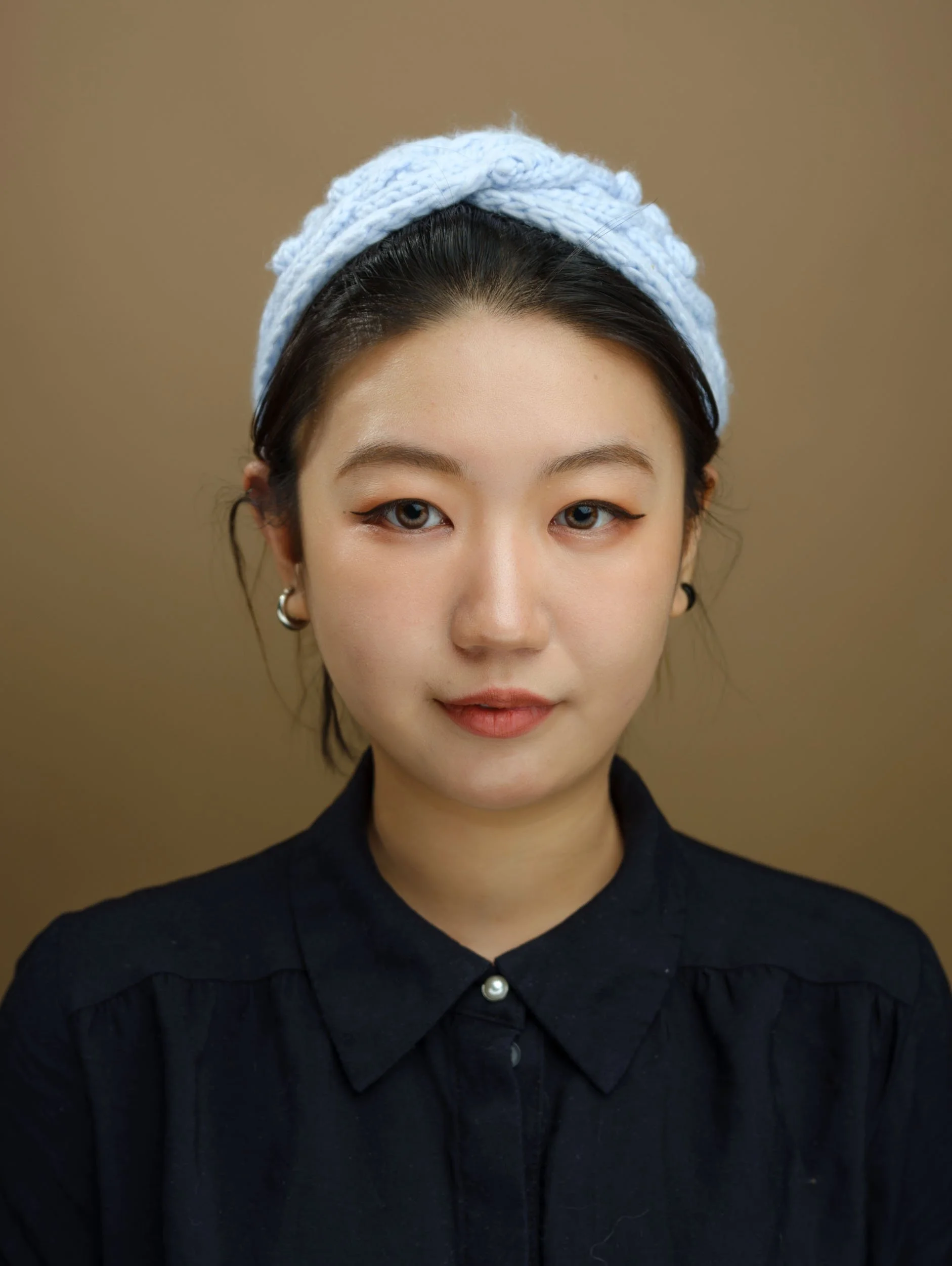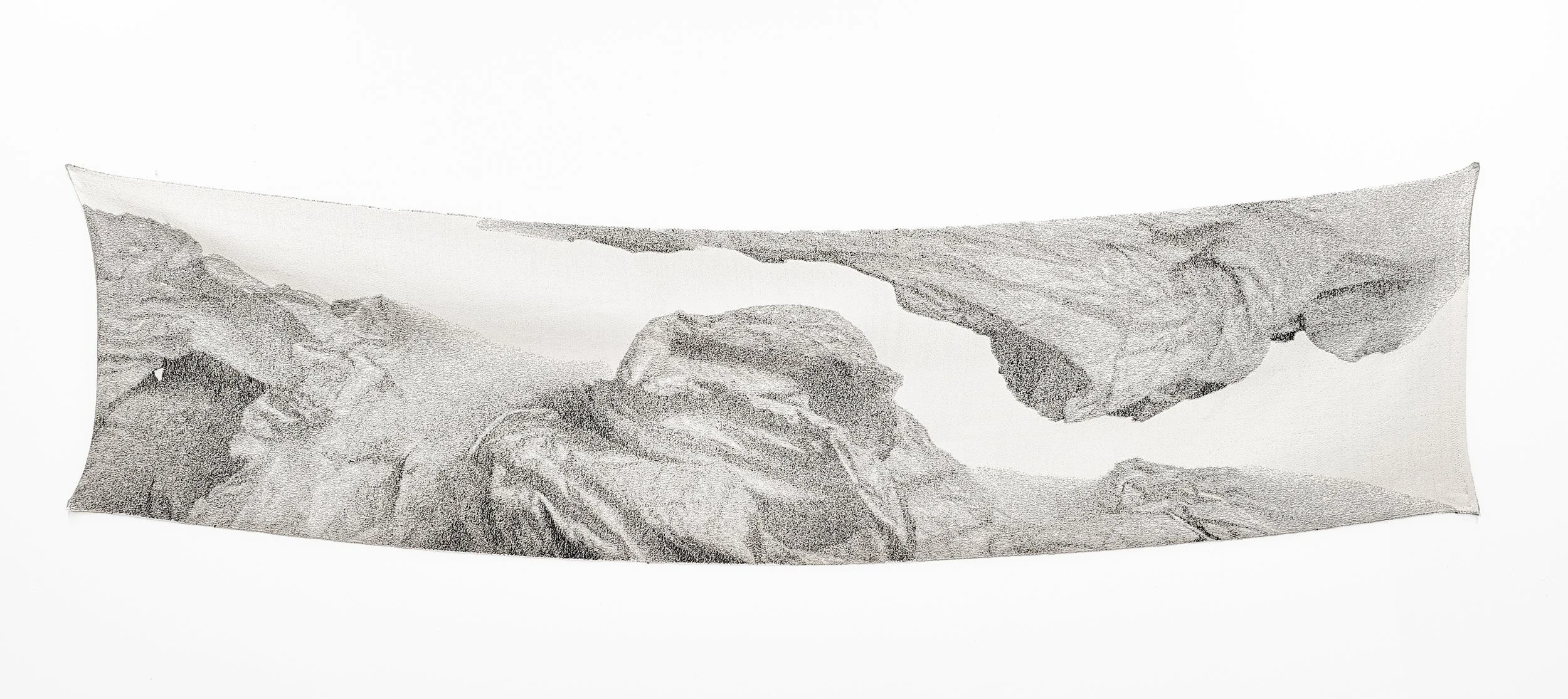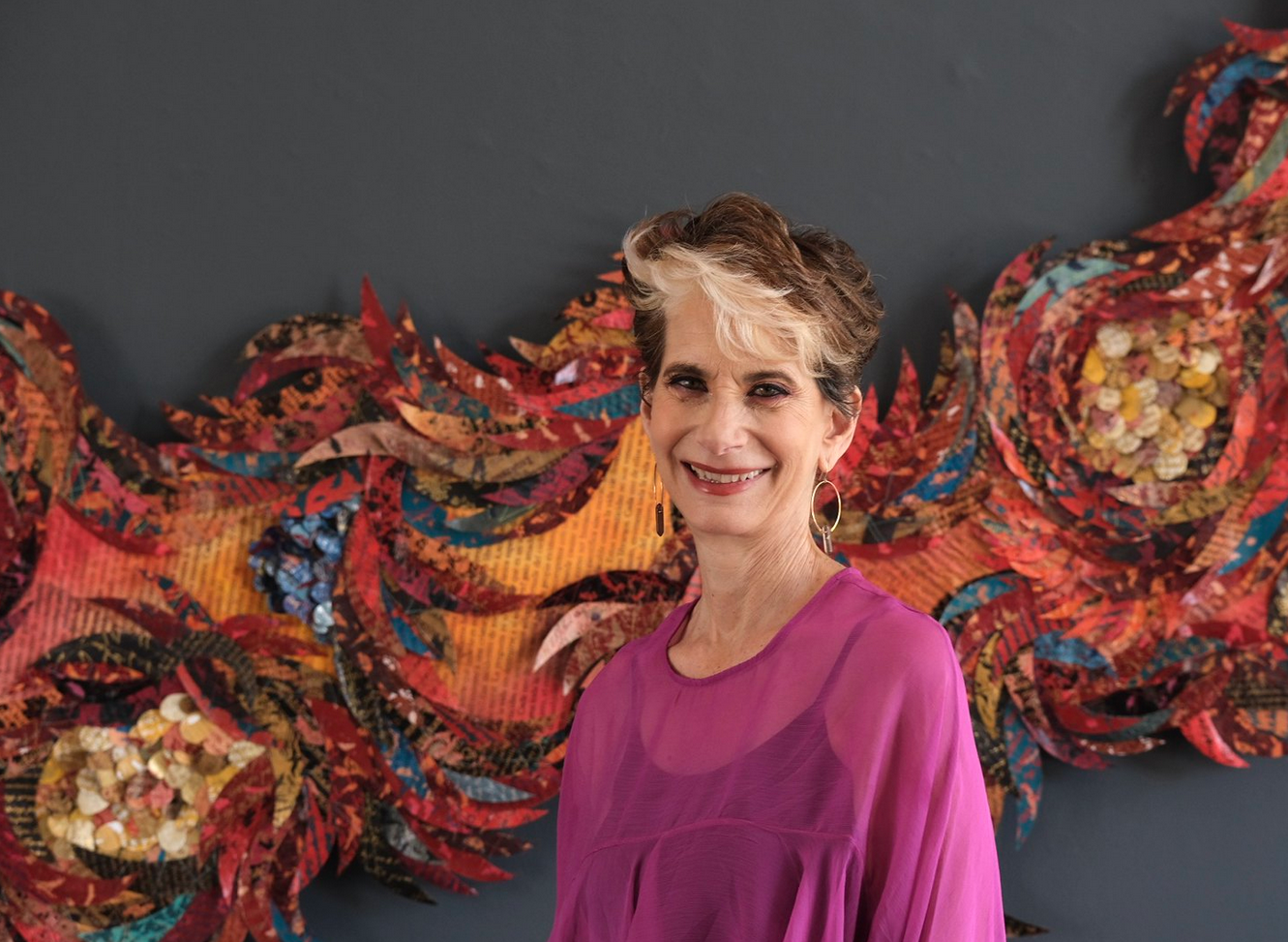10 Questions with Yicong Li
Yicong Li is an interdisciplinary artist and educator from Beijing, China. She is based in Chicago and holds a Master of Fine Arts from the School of the Art Institute of Chicago and a Bachelor of Fine Arts in Fibre from the Maryland Institute College of Art. Li's artistic vision merges influences from her diverse cultural background. She pushes the boundaries of fashion through masquerades and sculptural forms that interact with the body. She collaborates with local artists and designers and showcases her work in numerous exhibitions across the United States and globally.
Yicong Li - Portrait
ARTIST STATEMENT
Yicong Li is an interdisciplinary Chinese artist and educator working at the intersection of fibre and fashion. They use craft-based fibre techniques to create soft sculptures that wrap around the body, sometimes as headdresses, helmets, or masks, but always as something more. Drawing inspiration from Nuo Opera, an ancient ritual theatre form from Southwest China, their work explores transformation and empowerment through ceremonial performance. In this tradition, villagers don masks to become mythological deities, offering prayers for happiness and prosperity. In a similar spirit, their full-body masks are designed to shift the wearer’s contours, creating intimate spaces for inner connection and self-discovery.
Deeply influenced by psychology, their practice examines the relationship between human behaviour, the subconscious, and sociocultural contexts. As an educator at a local elementary school, they integrate reflections from daily interactions with students into their artistic process. Observing how children process emotions, confront challenges, and interact with the world continually informs their work, enriching their exploration of transformation and healing.
Their practice is inherently meditative. Repetitive motions like knitting and crocheting foster patience, presence, and focus. The artist finds grounding and comfort in these slow, rhythmic processes and seeks to translate that healing energy through their sculptures. Engaging multiple senses, each piece is an invitation to sanctuary for both wearer and viewer. Rather than adhering to fixed outcomes, they allow their forms to evolve intuitively, guided by energy, texture, colour, and technique. Wool and mohair—valued for their warmth and structure—are central to their material palette, reinforcing the themes of protection and embodiment.
Their work is about transformation: the transformation of thread into form, of the body into something otherworldly, and of craft into a space for reflection, empowerment, and healing.
© Yicong Li
INTERVIEW
You're originally from Beijing and now based in Chicago. How have your cultural experiences across these places shaped your artistic path?
I moved from Beijing to the United States when I was 16, so both cultures have shaped my upbringing at very different stages of life. Growing up in China gave me a deep connection to tradition and community, and a way of seeing the world that values subtlety and care. Coming to the U.S. during high school and continuing through college introduced me to a culture that encourages individuality, open expression, and questioning the world around me. Experiencing both systems has made me more observant and reflective. I have learned to approach my work with a broader perspective: drawing from the memories and values I grew up with and embracing new ideas and influences I have encountered here. That combination naturally shows up in my creative process. It helps me stay grounded in where I come from while being open to where I'm going.
Witness Installation, Mohair, Wool, Recycled Fiber Fill, Size Vary, 2023 © Yicong Li
You hold a BFA in Fibre and an MFA from the School of the Art Institute of Chicago. How did your studies influence the development of your current interdisciplinary practice?
Both my BFA in Fibre and my MFA from the School of the Art Institute of Chicago played an important role in shaping how I think and work as an artist today. During my time at MICA, I met a mentor who had a lasting impact on how I approach art. She encouraged me to explore who I am as an individual, to look inward, and to pay attention to the subconscious threads that run through my work. That was also when I began to understand the deep intimacy between the human body and fibre—the quiet language of touch, tension, and repetition. It taught me that fibre isn't just a material; it's a way of connecting to emotion, memory, and care—my time at SAIC built on that foundation. The interdisciplinary environment pushed me to think more expansively and to trust in experimentation. I started to bring in performance, installation, and research as a way to create more immersive and layered experiences. The freedom to move across mediums allowed me to develop a practice that is intuitive but also deeply grounded in meaning, bridging personal history with larger cultural narratives.
When did you first realise that art, especially fibre and fashion, would become your career path? Was there a turning point?
There was not a single dramatic turning point, but rather a gradual unfolding. In many ways, art is not a career I chose; it is something that chose me. I have been making art for as long as I can remember. It has always been there, a natural way for me to process the world, communicate, and feel grounded. I have also always been interested in fashion. It was something I loved intuitively, but for a long time, I was not sure how to bridge that interest with my art practice. That started to shift in college, especially as I worked more deeply with fibre. The material felt expressive and intimate, and it helped me slow down and pay attention to the body in a new way.
A key turning point came during my last year of college, when I took a year-long course called Multimedia Event, where we had to produce a runway performance. That experience taught me how to think about the whole body, not just in terms of clothing but as a performer and a presence. It pushed me to connect my sculptural work with performance and narrative. I also learned to think more comprehensively about my practice, how to shape a complete experience, and how to make sure each element of the work is intentional and thoroughly resolved.
Looking back, everything feels connected. Art has always been my way of understanding myself and the world around me, and fibre and fashion gave me the tools to express that understanding in a language that feels honest to who I am.
Witness, Mohair, Wool, Recycled Fiber Fill, Size Vary, 2023 © Yicong Li
Witness, Mohair, Wool, Recycled Fiber Fill, Size Vary, 2023 © Yicong Li
Your work merges fibre techniques with fashion and sculpture. What are your primary mediums and techniques, and how did you come to focus on these?
My primary mediums are wool and mohair, which I use alongside traditional fibre techniques such as knitting, crocheting, and felting. I was initially drawn to these materials because of their tactile qualities and emotional warmth. Wool has a certain sturdiness and the ability to hold form, which makes it ideal for sculptural garments. Mohair, in contrast, brings a softness and an ethereal texture that I find especially compelling. I enjoy the subtle changes in colour, texture, and shadow that mohair creates on the surface of the textile. It gives the work a sense of movement and depth, even when it is still.
I focused on these techniques through hands-on experimentation and an intuitive connection to the meditative nature of fibre work. The repetitive motions of knitting or crocheting give me space to reflect, and over time, I realised that this process was not only about making but also about healing, listening, and feeling. I want to translate the energy of the materials I work with into the pieces themselves, to give them a quiet power that can calm, soothe, and create space for emotional release.
Working at the intersection of fashion and sculpture allows me to create wearable forms that transform the body while carrying emotional and cultural meaning. I aim for each piece to hold energy, something you can feel simply by being near it, wearing it, or touching it.
Your practice is highly tactile and intuitive. Could you describe your creative process? How does a piece typically begin and evolve?
My creative process usually begins with a rough idea or inspiration. I often take inspiration from living creatures, particularly deep-sea animals and plants. I am drawn to what they represent—mysterious, ancient, and unknown. There is something captivating about forms that exist in darkness, untouched and otherworldly. These creatures often become a starting point for form, texture, or mood.
From there, I spend time with my materials, touching them, observing them, and responding to their texture and weight. There is a deep intimacy in that first contact, and I allow it to guide me. After I start working, I let my subconscious take over. I trust the process and the work will give me an idea of the next step. I keep adding, adjusting, and responding in an intuitive flow. I might begin with a loose sketch or a structural idea, but most form emerges through making. I am drawnto slowness and repetition, which is why fibre techniques like knitting or crocheting are critical to my practice. They give me space to reflect, and often the piece will shift direction based on an emotional response or unexpected rhythm in the material.
Over time, layers build. Texture, weight, and form evolve together. I adjust constantly, sometimes undoing hours of workto stay true to the energy I want the piece to hold. For me, making is a dialogue between memory, material, and emotion.The result is not just an object, but a space that can hold presence, offer comfort, and carry meaning.
Cassiopeia, Wool, Mohair, Fiber Fill, Tiger-eye Stones, 35x12x12 cm, 2025 © Yicong Li
Themes of transformation, ritual, and healing run deeply through your work. How do traditions like Nuo Opera and your interest in psychology come together in your pieces?
Traditions like Nuo Opera have been a powerful influence in shaping how I think about transformation and ritual. In Nuo, performers wear elaborate masks and costumes to become mythological figures such as gods, spirits, or ancestors. Through performance, they create a space for communal healing, protection, and transition. I am deeply inspired by this idea of becoming something beyond the self through physical transformation. It reflects how I want my work to function: as a portal for both the wearer and the viewer to enter a different state of being.
My interest in psychology, especially around trauma and emotional processing, ties closely into that. My work is a way to externalise what often remains invisible, such as inner states, memories, or wounds, and to hold those things gently. The process of making is slow and repetitive, which mirrors therapeutic practices. I want my pieces to create space for reflection, safety, and ritual, whether worn on the body or simply experienced in a room. By bringing together the ancient spiritual language of Nuo Opera and the inner work of psychology, I am looking for ways to connect cultural memory with individual healing. I see both tradition and personal introspection as vital to understanding how we move through change, how we carry pain, and how we release.
You also work as an educator. How do your interactions with children in the classroom influence your studio practice?
Working as a classroom teacher is very challenging, but it also profoundly informs my studio practice. Observing and analysing children is a key part of my job, and it directly connects to how I approach my art. I work with many unique students who face social and emotional challenges, and interacting with them has expanded my understanding of the therapeutic potential of art. These interactions have helped me see how art can serve as a tool for emotional processing and healing.
Children's raw, unfiltered expressions of joy, frustration, and curiosity remind me of the importance of creating work that invites genuine engagement. I draw inspiration from their authenticity and ability to embrace spontaneity, encouraging me to be more experimental in my creative process. Much like in the classroom, where I strive to create a safe space for my students to explore their emotions, my studio practice allows me to express and evolve through material, form, and texture.
Additionally, working with children has sparked my interest in art therapy. It has encouraged me to explore how art can function as a healing tool, whether through tactile interaction with my sculptures or by inviting reflection. As children engage with the world through their senses, I aim to create art that touches the viewer's senses, offering a space where emotions can be reflected, processed, and healed.
Bound, Recycled Yarn, Fiber Fill, 65x60x40 cm, 2023 © Yicong Li
Bound, Recycled Yarn, Fiber Fill, 65x60x40 cm, 2023 © Yicong Li
Bound, Recycled Yarn, Fiber Fill, 65x60x40 cm, 2023 © Yicong Li
Your wearable sculptures and full-body masks have been shown in exhibitions across the U.S. and internationally. How has your work been received, and do audiences respond differently in different cultural contexts?
The reception of my wearable sculptures and full-body masks has varied across cultural contexts. In the U.S., audiences are often fascinated by the idea of transformation, seeing it through the lens of self-exploration and empowerment. Internationally, especially in cultures with strong spiritual practices, my work is often viewed as a ritualistic or communal experience, where masks symbolise a connection to ancestral traditions and transformation.
Children are particularly drawn to my work, captivated by the colourful, playful nature of the sculptures. They enjoy these pieces' tactile qualities and the sense of fun. My work invites emotional responses, evoking reflections on transformation that resonate universally, whether in personal empowerment or collective rituals.
What are you currently working on, and what themes or collaborations are you looking forward to exploring next?
I am currently working on Cassiopeia · Jade, an extension of my sculptural piece Cassiopeia. This new work deepens my exploration into the therapeutic nature of textiles and texture, building on the themes of movement, light, and transformation present in the original Cassiopeia. The piece is inspired by the duality of fluidity and permanence, the earthly and the celestial, reflected in both the Cassiopeia jellyfish and the constellation it shares its name with. The jellyfish, with its slow, undulating drift, embodies softness and adaptability—qualities that mirror the healing rhythm of breath and water. The constellation, on the other hand, is fixed in the cosmos, symbolising myth, endurance, and eternal light.
Cassiopeia · Jade continues to explore this balance between movement and stillness, the ephemeral and the enduring, inviting reflection and healing. In this series, I have introduced beading elements, using stones and pearls to explore the emotional impact that different colours and textures evoke in humans. These beaded additions add depth and nuance to the piece, highlighting how materials like stones and pearls can influence the viewer's emotional experience. Wool and mohair yarns still form the base, offering a tactile softness, while a gradient of colours mimics the organic shifts seen in deep-sea creatures and nebulae. Tiger eye stones embedded within the fibres channel resilience and protection, further grounding the piece.
Through Cassiopeia and Cassiopeia · Jade, I aim to envelop the viewer in a gentle, pulsating presence, creating a space where the body can drift, glow, and heal. The work is a tactile meditation on how texture and form can influence our emotional and physical states and a reflection of how art can serve as a tool for transformation.
Vegetate, Mohair and Wool, 48x50x59 cm, 2024 © Yicong Li
Lastly, where do you see yourself and your work in five years from now?
Teaching has brought me immense joy and fulfilment, and it has become a big part of who I am. In the next five years, I see myself continuing to balance my work as an artist and my passion for education and psychology. I want to explore art therapy or museum education, combining my love for art with a deeper desire to help others through creative expression. I am at a crossroads right now, and I am still figuring out which path feels most aligned with my journey, but one thing I know for sure is that my love for art is constant, and it will always be a part of my life. I envision both myself and my work growing in a direction that holds the power to heal and support those in need. Whether in a classroom, a museum, or a therapeutic space, I hope what I create can offer comfort, connection, and care. I will keep making art, no matter what.
Artist’s Talk
Al-Tiba9 Interviews is a promotional platform for artists to articulate their vision and engage them with our diverse readership through a published art dialogue. The artists are interviewed by Mohamed Benhadj, the founder & curator of Al-Tiba9, to highlight their artistic careers and introduce them to the international contemporary art scene across our vast network of museums, galleries, art professionals, art dealers, collectors, and art lovers across the globe.
























